See Also: Dudjom Tersar | Longchen Nyingtig | Namcho & Palyul
___________________
Guru Rinpoche | Mandarava | Rongzompa | Longchenpa | Jigme Lingpa | Patrul Rinpoche |
Sera Khandro | Mipham Rinpoche | Dilgo Khyentse | Dudjom Rinpoche
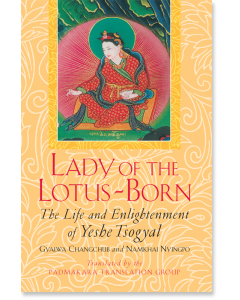
By Gyalwa Changchub
By Namkhai Nyingpo
Translated by Padmakara Translation Group
By Yeshe Tsogyal
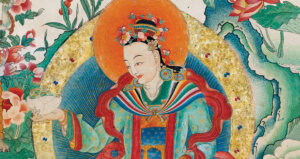
Yeshe Tsogyal: A Guide for Readers to the Dakini Princess

See Also: Dudjom Tersar | Longchen Nyingtig | Namcho & Palyul
___________________
Guru Rinpoche | Mandarava | Rongzompa | Longchenpa | Jigme Lingpa | Patrul Rinpoche |
Sera Khandro | Mipham Rinpoche | Dilgo Khyentse | Dudjom Rinpoche
The first Tibetan ever to attain complete enlightenment was in all probability the woman Yeshe Tsogyal, closest disciple of Padmasambhava, the master who introduced the Buddhist teachings to Tibet in the eighth century. The first three books below are not just biographies—and very different from each other both in emphasis as well as some of the events accounted for—but inspiring examples of how Buddha’s teaching may be practiced. Although these texts are of great antiquity, they nevertheless expresses a tradition that is still alive today and is an archetypal description of the teacher-disciple relationship. Yeshe Tsogyal follows the complete Buddhist path, including the Dzogchen teachings, and herself becomes a Guru of great power and wisdom. Passages of profound teachings are offset by episodes of exploit and adventure, spiritual endeavor, court intrigue, and personal encounter. Hers is a dramatic story, full of beauty and song, and offers an intimate glimpse of Tsogyal’s feelings, aspirations, hardships, and triumphs.
$24.95 - Paperback
By Yeshe Tsogyal, Namkhai Nyingpo, and Gyalwa Changchub
Foreword by Jigme Khyentse Rinpoche
Translated by The Padmakara Translation Group
Lady of the Lotus-Born is a terma, or Dharma Treasure, written and concealed in the eighth century for future generations by the accomplished masters Namkhai Nyingpo and Gyalwa Changchub, the disciples of Padmasambhava and Yeshe Tsogyal. The text was discovered nearly a thousand years later in the seventeenth century by the Tertön (Dharma Treasure finder) Taksham Samten Lingpa, who, by interpreting the symbolic script of the dakinis (reproduced at the beginning of each chapter), revealed the text in its entirety as it has been handed down to us.
$24.95 - Paperback
By Yeshe Tsogyal, rediscovered by Drime Kunga and Jamyang Khyentse Wangpo, and translated by Chonyi Drolma
Foreword by Dzongsar Khyentse Rinpoche
The many layers of the heroic life of Yeshé Tsogyal, Tibet’s best-known dakini and female master, are revealed in this inspiring work. Translated here for the first time, this terma, or “hidden treasure,” presents an outer narrative of her birth, family, and struggles in a traditional male-dominated society; an inner account of her meetings with the great master Padmasambhava; and a secret chronicle of her retreat at Chimpu and her visionary journey to Oddiyana. This accomplished translation is enriched by the refreshing insights of six contemporary scholars and teachers of Tibetan Buddhism, making this invaluable guide to the life of Yeshé Tsogyal a treasure for practitioners, scholars, and anyone intent on the possibility of awakening.
You can read a piece from the book Judith Simmer-Brown wrote here.
By Taksham Nuden Dorje, translated by Keith Dowman
Foreword by Thinley Norbu Rinpoche
Another terma text is this extraordinary work, discovered by Taksham Nuden Dorje n the seventeenth century.
An Thinley Norbu Rinpoche says in the foreword,
Those who read the biography of the supreme tantric master, Padma Sambhava, and his Consort, Yeshe Tsogyal, have the chance to identify with them, and those who cultivate the inner wisdom Dakini:, the root Dakini:, progress towards becoming the supreme Sky Dancer, incomprehensible feminine wisdom,
the lover without motive.
and
In the dharmakaya's stainless space Yeshe Tsogyel is Kuntuzangmo, infinite and noble femininity itself. These names and qualities are no more than
indications of the nature of the dharmakaya which can never be contained in, or identified by, concepts. Sambhogakaya is the
glowing awareness of the dharmakaya, where the Five Buddhas and their Consorts appear as unobstructed luminous space-form. As the feminine aspect in the sambhogakaya, Yeshe Tsogyal is the Five Wisdom-Consorts.
$24.95 - Paperback
by Nyoshul Khen Rinpoche
Translated and introduced by David Christiansen
Nyoshul Khen Rinpoche was one of the most important teachers of the 20th century - an important teacher to some of the best living teachers. In the pages of this book, Yeshe Tsogyal appears throughout. Here is one section:
At present we are practicing the meditation deity in the form of the dakini, from the terma treasure teachings of the second Dudjom Rinpoche, Jigdral Yeshe Dorje (1904–87). It is a teaching that has been revealed specifically for the benefit of beings in this dark age. This practice stems from the compassion of the three jewels and the blessings and aspirations of the buddhas and is an actual method to accomplish Guru Padmasambhava’s consort Yeshe Tsogyal. The dakini Yeshe Tsogyal is the nirmanakaya emanation of dharmadhatu Samantabhadri, the consort of the dharmakaya buddha Samantabhadra, who is the female aspect of the ultimate deity (don gyi lha).
In order to help us realize this state for ourselves, through the power, blessings, and aspirations of Buddha Samantabhadra and consort, the dakini Yeshe Tsogyal arises as their actual manifestation and is born into this world. Yeshe Tsogyal was blessed and taught by Guru Padmasambhava and as part of her various enlightened activities, she wrote down and transmitted a method to follow her and accomplish the essence of her awareness wisdom (rig pa’i ye shes kyi ngo bo). Thus we have the practice of Yeshe Tsogyal as a yidam or meditation deity.
$28.95 - Paperback
To call Cascading Waterfall a book on the preliminary practices is a bit like calling the Mt. Everest a hill. Coming from the vast wisdom mind of Longchenpa's emanation in our age, it is an indespensible guide to the path. And Yeshe Tsogyal, who Rinpoche describes as Kuntuzangmo appearing in form, appears throughout.
Rinpoche includes a translation of Mipham Rinpoche's prayer to Yeshe Tsogyal, The Longing Melody of Faith.
And the second part of the book is a commentary on the meaning of “The Continuously Blossoming Rosary of the Lotus Assembly Palace” called The Light Rays of the Youthful Sun and Rinpoche offers us many teachings on the Great Exaltation Queen Yeshe Tsogyal who features in the prayer.
$24.95 - Paperback
By Namtrul Jigme Phuntsok and Khandro Tare Lhamo
Introduced and translated by Holly Gayley
Namtrul Jigme Phuntsok and Khandro Tare Lhamo were an extraordinary 20th century terton visionaries as the translations of love letters. Tare Lhamo is widely considered an emanation of Yeshe Tsogyal and this connection appears throughout Gayley's introduction as well as the letters themselves.
The letters are poetic, affectionate, and prophetic, articulating a hopeful vision of renewal that drew on their past lives together and led to their twenty-year partnership. This couple played a significant role in restoring Buddhism in the region of Golok once China’s revolutionary fervor gave way to reform.
$34.95 - Paperback
By Khenpo Tsewang Dongyal
This biography of Dudjom Rinpoche references Yeshe Tsogyal throughout. It includes the Seventh Heap of Lightbeams which a brief explanation of Kyabje Rinpoche’s enthronement as a great tertön and regent of Guru Padmasambhava and of how Guru Rinpoche and wisdom dakini Yeshe Tsogyal entrusted him with terma. Kenpo Tsewang also shares how in some terms teachings terma teachings it says that Guru Padmasambhava and Yeshe Tsogyal reincarnated together in the form of His Holiness Dudjom Rinpoche, so that he was their actual presence—only the body was different.
$39.95 - Paperback
This is a classic of scholarship on the Dakini principle from the point of view of a practitioner. Yeshe Togyal is discussed and referenced throughout. Here is a sample:
As for her inner dimension, Yeshe Tsogyal was remarkable because she was not merely a mortal; in her dynamic nature she was a tantric Buddhist meditational deity. She is called Sarasvati (Yangchenma), the great female bodhisattva of learning, culture, and music, the peaceful consort of Manjusri, who carries a lute that serves as her symbol. Sarasvati is also called Vakisvari, (Ngawang Lhamo) or ‘‘lady of speech’’ for her connection with seed syllables, music, utterance, and poetry. She is the dakini of the mirrorlike wisdom, and the ‘‘white-cloaked lady’’ (Ko Karmo) who is dakini of inner heat in the yogic practice of tummo. It is said that Yeshe Tsogyal was Sarasvati in her previous life.
Yeshe Tsogyal in her visionary dimension was the radiant White Tara (Drolma Karmo) the savior who, with her compassionate seven eyes, attends to the health and welfare of beings in all quarters. In another manifestation, she was Vajrayogini or Vajravarahi, who are two aspects of the most important dakini in the Tibetan tantric system. Vajrayogini is a semiwrathful deity, depicted as red and dancing, wearing bone ornaments; she is the most expressive of the qualities of wakefulness, the personification
of the widsom-mind itself. In her alternate identity as Vajravarahi she is the ‘‘Vajra Sow,’’ the manifestation of the nonconceptual quality of the mind, who severs thought with her hooked knife


The biography in the Treasury of Lives site, like several other sources, alludes to Kharchen Pelgyi Wangchuk possibly being Yeshe Tsogyal's brother.
However, in Yeshe Tsogyal's biography by Gyalwa Changchub and Namkhai Nyingpo which was discovered by the Terton Samten Lingpa and published in English as Lady of the Lotus-Born, Kharchen Pelgyi Wangchuk was the chieftain of one of the seven fiefdom's of Tibet's rulers, and had a vision along with his wife while "at play in the delights of love. " After this there were dreams and sometime later Yeshe Tsogyal was born.
Later, he became a disciple of Guru Rinpoche. In Naked Awareness, Karma Chagme relates how Kharchen Pelgyi Wangchuk achieved liberation. Guru Rinpoche said to him: " Palgyi Wangchuk, listen! The mind is primordially insubstantial, without anything on which to meditate. To the intellect it is ungrounded and unmodified. Let it be self-arisen and self-displaying. Dwelling in that state, you become a Buddha without rejecting the cycle of existence.' Thus Palgyi Wangchuk was liberated. "
He is also briefly discussed in the second volume of the second volume of the Treasury of Knowledge.
Furthermore, in The Ruby Rosary Kyabje Thinley Norbu Rinpoche offers a commentary on a short prayer written by his father H.H. Dudjom Rinpoche illuminating the lives of great yogis, scholars, and masters of the Buddhist lineage in addition to describing the early spread of Buddhism in Tibet beginning with the direct disciples of Guru Rinpoche such as Kharchen Pelgyi Wangchuk.
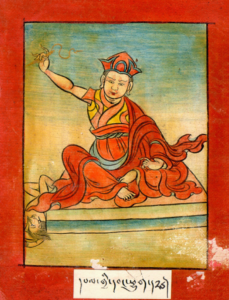
$34.95 - Paperback
By: Gyalwa Changchub & Namkhai Nyingpo & Padmakara Translation Group
The Treasury of Knowledge: Books Two, Three, and Four
$49.95 - Hardcover

This series of blog posts are meant to be resources guides to complement the biographies of the great masters and scholars on the Treasury of Lives site.
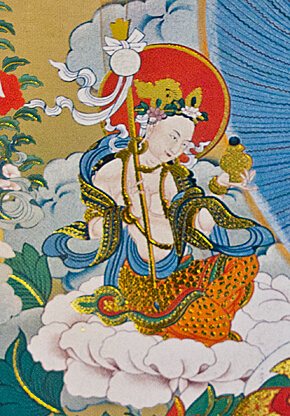
Mandarava
Mandarava was one of the great 8th century adepts and was one of the main consorts of Guru Rinpoche. As such a central figure at the time of Guru Rinpoche, she is a focus of many works.
A wonderful complete biography was published by our friends at Wisdom Publications as The Lives and Liberation of Princess Mandarava.
A short account of her life by Sarah Jacoby is on the Treasury of Lives site.
In Crazy Wisdom which is included in The Collected Works of Chögyam Trungpa, Volume 5, Trungpa Rinpoche describes the scene when Mandarava met Guru Rinpoche:
"One day he visited a nunnery. At this particular nunnery lived a princess called Mandarava, who had just recently become a nun and had completely turned away from worldly pleasure. She lived in seclusion, guarded by five hundred women, whose task was to make sure that she maintained her monastic discipline. When Padmasambhava arrived at the monastery, everyone was quite impressed with him-naturally. He had the innocence of one born from a lotus and a pure and ideal physique. He was very beautiful. He converted all the women in the nunnery: they all became his students. "
In Lady of the Lotus-Born, there is a wonderful scene where Mandarava and Yeshe Tsogyal, Guru Rinpoche's most well-known consorts, bestow teachings on each other:
"Mandarava requested the twenty-seven pith instructions, a special teaching of the Guru, unknown in India. And Tsogyal offered them to her. Now Mandarava was a dakini of longevity, a Lady of Immortal Life, and so Tsogyal asked her for the seven pith instructions of long life, as well as the thirteen pith instructions on Hayagriva and other deities, all of which teachings she concealed as Treasures. "
There follows an exchange of offering verses between the two of them. First, from Yeshe Tsogyal:
Om Ah Hung!
Dakini who won the diamond state of deathlessness,
Whose body, like a rainbow, rides upon the sky,
You pass with mastery through things unhindered,
And crush the Demon Lord of Death,
And overthrow the Demon of the Aggregates.
Freed from shackles of the Demon of Defiled Emotion,
You humbled and brought low the Demon Son of Gods:
Dakini and mistress of longevity,
Is this not yourself?
From highest Akanishta down,
Throughout the three dimensions of existence,
Of every high and noble one you are the mistress.
The body of Great Bliss is yours,
Mandarava, sublime patterning of voidness,
Mother of wanderers, to you I bow!
For beings in the endless karmic stream of birth and death,
Caught on the mill-wheel driven
By the torrent of impure delusion,
You close the door to their descent and fall.
May my prayer to be as you are be fulfilled.
When karma is exhausted and the thought of pleasure vanished,
When the mire of delusion has dried up,
When the three worlds, all samsara, are exhausted
And every thought extinguished-
In the sphere of Great Bliss blissfully enclosed,
May I be never separate from Samantabhadri of Great Bliss.
Thus she prayed and requested many pith instructions that had never been heard of in Tibet. Then the queen of siddhas, Princess Mandarava, answered:
Kyeho!
Accomplished in the Secret Mantra,
Dancer in the sky,
Wonder-worker who dissolved her impure form
Into the sphere of purity,
You drank the nectar of the teachings
Of the Lotus-Born
And gathered all their essence-
Great Mother, Wisdom that has gone beyond,
Is this not yourself?
Entering the path wherein the truth
Of all phenomena is seen,
You utterly forsook the eight preoccupations of this life
And, practicing austerities, lived upon essential substance,
Overcoming all phenomenal existence.
Tsogyal, ever-young, immaculate, to you I bow!
Sinful beings in the endless cycle of samsara,
Blown by the hurricane of karma-
These you tame and guide most skillfully.
Establishing the Dharma, you undid
The devilish perversity of Bon.
Mistress, sovereign strength, may I be one with you!
Hereafter in the purity of infinite pure space,
Which is the pure expanse of Lotus Light,
Bathed in the beams of Pema Tho ¨dreng's love,
May you and I together send out emanated forms
To work enlightened actions,
Churning thus the three worlds of samsara!
And with this prayer, she disappeared into space. "
Mandarava is featured throughout Guru Rinpoche: His Life and Times where Lama Ngawang Zangpo points out it was not her status as consort that mattered but rather that she and Yeshe Tsogyal "were the best among Guru Rinpoche's disciples, men or women; their inclusion in countless paintings and sculptures of the master is a tribute to their personal enlightenment during an era of social enlightenment. "
Included in Guru Rinpoche are several short biographies of his life. In Jamgon Kongtrul's account, he introduces Mandarava thusly:
"Mandarava, daughter of Arsadhara, king of Zahor, was a woman who showed all the signs of being a dakini. The Master seduced her and accepted her as his consort and companion in spiritual practice. After three months of longevity meditation in Maratika Cave, the lord protector Buddha Infinite Life [Amitayus] appeared in person, bestowed empowerment, and blessed them as inseparable from him. When the Buddha imparted a billion tantras of longevity, they attained accomplishment of the state of an awareness holder who controls longevity. Their bodies became adamantine, beyond birth and death. "
Mandarava is an important part of many practices, whether explicitly as Guru Rinpoche's consort, or symbolically as Guru Rinpoche's khatvanga as described in Shechen Gyaltsap's A Practice of Padmasambhava [link and image] or Thinley Norbu Rinpoche's Cascading Waterfall of Nectar.
Mandarava is also a close link in the treasure tradition.
In the Autobiography of Jamgon Kongtrul, the author relates how he discovered as a terma a piece of Madarava's clothing along with some other precious objects.
Mandarava is very strongly associated with the Maratika cave and longevity. This can be seen in Chogyal Namkhai Norbu's account of his experiences at Maratika in Dream Yoga and the Practice of Natural Light where he relates his dreams of Mandarava before discovering a gongter, or earth treasure, there.
Mandarava also features in several modern scholarly books as a model of the feminine principle.
In Dakini's Warm Breath: The Feminine Principle in Tibetan Buddhism, Naropa professor Judith Simmer-Brown explores the importance and role of Mandarava.
In Feminine Ground, Jan Willis also explores Mandarva and what she represents, through a contemporary lens.
The dakini Niguma, the founder of the Shangpa Kagyu lineage and the sister of Naropa, is considered a reincarnation of Mandarava.
Further Resources:
TBRC Reference: http://tbrc.org/#!rid=P00AG0428
Treasury of Lives Site: http://treasuryoflives.org/biographies/view/Mandarava/9
$34.95 - Paperback
By: Gyalwa Changchub & Namkhai Nyingpo & Padmakara Translation Group
The Collected Works of Chogyam Trungpa: Volume Five
$49.95 - Hardcover
Kawa Peltsek - The Fully Accomplished Translator of Shantideva

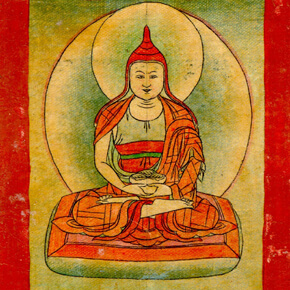
He was responsible for translating key texts including Shantideva's Bodhicharyavatara. Khenpo Ngawang Pelzang relates this in The Nectar of Manjushri's Speech, and quotes Ngok Loden Sherab who said "Kawa, Chokro, Zhang are like the sun and moon together....Compared to them we are but fireflies".
He is also mentioned repeatedly in Gyalwa Changchub's Lady of the Lotus Born.
Jamgon Kongtrul also talks about Kawa Peltsek and the whole process of translation in Book Six Parts 1 & 2 of his Treasury of Knowledge.
Full bio on the Treasury of Lives: http://bit.ly/kawa-peltsek
TBRC Resources for Kawa Peltsek: http://tbrc.org/#!rid=P8182
$34.95 - Paperback
By: Gyalwa Changchub & Namkhai Nyingpo & Padmakara Translation Group
The Treasury of Knowledge: Book Six, Parts One and Two
$49.95 - Hardcover
